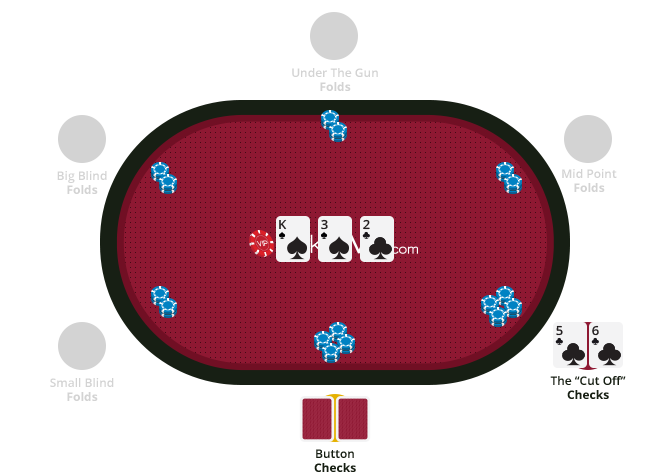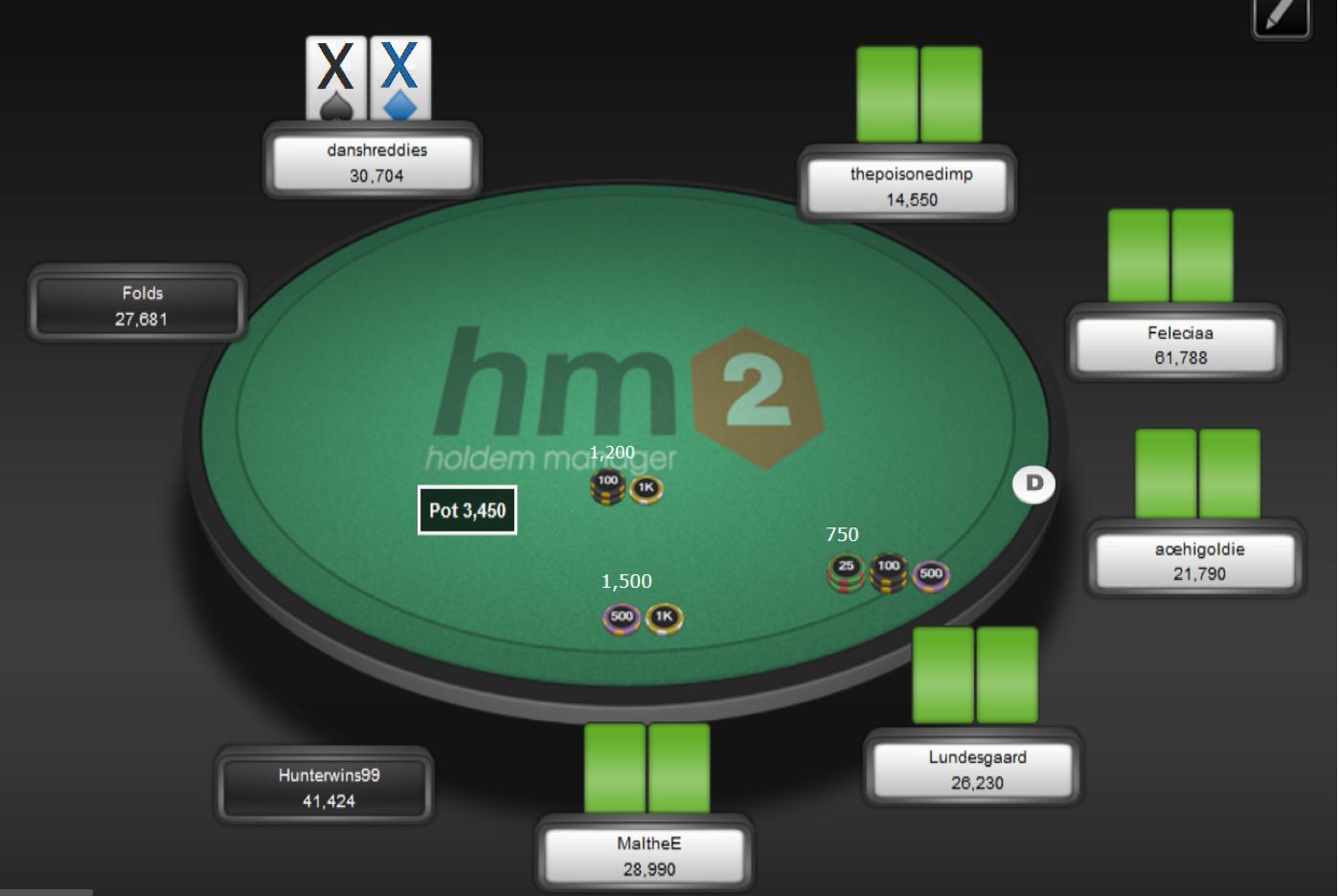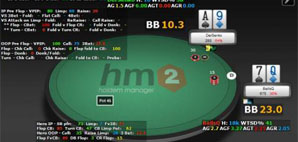Poker HUD (Heads Up Display) is a very useful tool, but it can be rather confusing due to the amount of stats and numbers available. This article looks into some advanced HUD stats that you are probably not using and that could come in handy if you start implementing them to your day-to-day games.
Notecaddy/Advanced-HUD-stats
Most players who play regularly make use of a
HUD. However,

in some cases we may be using the same HUD/popups that we created several years ago and have not kept up to date with some of the more advanced features that are available for use. This article is written with HM2 in mind, although we should be able to find similar stats in PT4. While there is additional tracking software available, we will often find these programs limited in terms of the tools/stats they offer. They simply do not have the support that HM2/PT4 have.
Notecaddy
The biggest upgrade in recent times is Notecaddy. There is an equivalent note-tracker for PT4 although this is arguably much less powerful. However, this comes free with PT4 while it is a paid upgrade for HM2. PT4 is a great choice if we are on a budget or have a computer which runs slowly. If money is no object and we have a fast computer, HM2 is superior software in many ways.
Notecaddy takes automated notes on our opponents and displays this information in a popup. This helps to augment and complete the information we already have via means of a statistic. Imagine our opponent 3bets us with a frequency of 10%. This is useful information but by no means complete. Is this is a polarized 10% range or a merged 10% range? Even if we know that it is polarized does our opponent favour offsuit broadways in his bluffing range or speculative hands? How wide will he go for value? If we open up our note-caddy popup we can see the specific type of hands our opponent has 3bet in the past providing a more complete picture.
Notecaddy - Custom Stats
An excellent feature of Notecaddy is the ability to create our own custom stats using a simple scripting system. This many not be the easiest thing to grasp quickly but has the potential to be extremely useful.
For example, imagine the situation where we'd like to know how wide we should open in a standard BTN steal attempt. The ideal stat for this situation might be "fold blinds to BTN steal". At the time of writing this article, HM2 has "fold SB to BTN steal", and "fold BB to BTN steal", but no "fold blinds to BTN steal".

We can also create custom stats that involve bet-sizing information, something that could not be done previously with the power of tracking software alone. Imagine we face a 4x open from the BTN. We are aware that this is a non-standard sizing, and we are aware that according to our HM2 stats our opponent has a 50% opening range from the BTN. But does he necessarily open a 50% range with this 4x sizing, or does he reserve this sizing for a much stronger range? Using custom stats it is possible to break our opponents raise-first-in range into the various sizings he uses and see which frequency he uses the 2x, 3x, or 4x open raises. Perhaps he rarely raises to 4x in which case we can make some exploitative folds.
Notecaddy Packages
It's a good point to mention that getting to grips with
notecaddy can involve a learning curve which isn't super easy. It's well worth the time invested - but there is still a reasonable chance that some of us a) don't have the time to invest figuring it out or b) honestly just find scripting custom stats too tricky.
Not to worry, there are people out there prepared to do all the hard work.....for a price. There are companies out there who have decided to create what is known as a "coaching package" for notecaddy. This is a file that you import into notecaddy that involves a complete HUD and a selection of advanced custom stats along with custom badges that allow us to easily identify certain traits in our opponents.
We will not mention any specific packages so as not to advertise, but a quick google search should allow us to find the available coaching packages without too much difficulty. Be prepared to pay in the region of $70-$200 for this kind of tool. Everything included in a package will be something you could code yourself if you have the time and the ability, so it's definitely not mandatory you pay anything at all once you have purchased the initial notecaddy software.
Notecaddy - Scattergraphs
Very likely one of the most useful tools of notecaddy is the scattergraph. Imagine we are facing a pot-sized bet on the river. Perhaps we know the frequency with which our opponent fires the river, but we are not sure how his river sizing affects his frequencies.
The scattergraph which can be found in the notecaddy popup gives us information regarding how strong our opponent is when he uses various sizings. We have strength on one axis and bet sizing on another axis. We might find that when our opponent bets pot he is frequently bluffing, whereas the smaller sizings are weighted toward value. This is easily one of the best tools for river situations, but has application on the earlier streets too. In pretty much any situation it is possible to see a graph of how our opponent's bet-sizing relates to the strength of his hand.
Notecaddy - Clock
Vs Hero Stats
This is something that should be available within the tracking software itself. We might know how often a player is 3betting at the table, but perhaps it seems like he is 3betting specifically against us way more often than average.
It is now possibly to quantify this information with the "vs-hero-3bet" stat. We can see how often our opponent is 3betting (or a whole range of other actions) specifically against us without having to closely follow the action on that table.
Other Advanced Stats
In general

the average player is simply not aware of many of the stats that are available for use. We will consider one example, but it's highly recommended at some point to work through the list of available stats in our tracking software. We may find there is a certain stat that is extremely useful; one that most players have never considered using.
Perhaps we have on our HUD the "fold-cbet-to-raise" stat. Many players do; it's an extremely useful stat. But have we ever considered that having that stat in isolation is not maximising its effectiveness? Imagine our opponent has an extremely low "fold-cbet-to-raise" stat. Our natural inclination is to avoid bluffing this guy; what's the point of bluffing if he rarely folds?
Ironically we may find that we are missing on an excellent bluff situation. Imagine we now add the more advanced stat "fold to turn barrel after cbet-cal flop", and we see that it is over 80%. How do we feel about raising the flop now? Hopefully we can see that despite not generating instant profit on the flop it should be a clearly profitable bluff-raise since we can barrel the vast majority of turns and expect to win the pot.
By extension, just because the "fold to turn barrel after cbet-call" is really low doesn't necessarily mean we can't profitably fire the turn. We'd want to check out "fold to river barrel after cbet-call flop, call turn barrel". The point is that stats are rarely at their maximum effectiveness when used in isolation
This same situation works in reverse too. Many players have the "raise-vs-flop-cbet" stat on their HUD. But this is not necessarily a complete picture that allows us to establish how often we should call vs raises on the flop. Imagine we check our opponents "barrel turn after raise vs flop cbet" stat and we see he rarely fires the turn. It may indicate that we can call wider expecting to see free cards on river, perhaps including some profitable bluff opportunities. By extension would could add an additional stat that shows how often our opponent will fire the river after he fires the turn.
This is just one example. There should be countless other available stats that allow us to make more effective use of the current stats. Since many of the new stats we find will be considered secondary stats, they will generally do better as part of a popup rather than on the main HUD.
 in some cases we may be using the same HUD/popups that we created several years ago and have not kept up to date with some of the more advanced features that are available for use. This article is written with HM2 in mind, although we should be able to find similar stats in PT4. While there is additional tracking software available, we will often find these programs limited in terms of the tools/stats they offer. They simply do not have the support that HM2/PT4 have.
in some cases we may be using the same HUD/popups that we created several years ago and have not kept up to date with some of the more advanced features that are available for use. This article is written with HM2 in mind, although we should be able to find similar stats in PT4. While there is additional tracking software available, we will often find these programs limited in terms of the tools/stats they offer. They simply do not have the support that HM2/PT4 have. We can also create custom stats that involve bet-sizing information, something that could not be done previously with the power of tracking software alone. Imagine we face a 4x open from the BTN. We are aware that this is a non-standard sizing, and we are aware that according to our HM2 stats our opponent has a 50% opening range from the BTN. But does he necessarily open a 50% range with this 4x sizing, or does he reserve this sizing for a much stronger range? Using custom stats it is possible to break our opponents raise-first-in range into the various sizings he uses and see which frequency he uses the 2x, 3x, or 4x open raises. Perhaps he rarely raises to 4x in which case we can make some exploitative folds.
We can also create custom stats that involve bet-sizing information, something that could not be done previously with the power of tracking software alone. Imagine we face a 4x open from the BTN. We are aware that this is a non-standard sizing, and we are aware that according to our HM2 stats our opponent has a 50% opening range from the BTN. But does he necessarily open a 50% range with this 4x sizing, or does he reserve this sizing for a much stronger range? Using custom stats it is possible to break our opponents raise-first-in range into the various sizings he uses and see which frequency he uses the 2x, 3x, or 4x open raises. Perhaps he rarely raises to 4x in which case we can make some exploitative folds.

